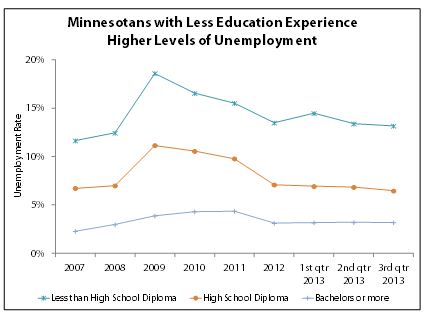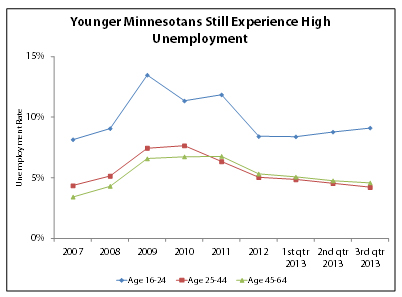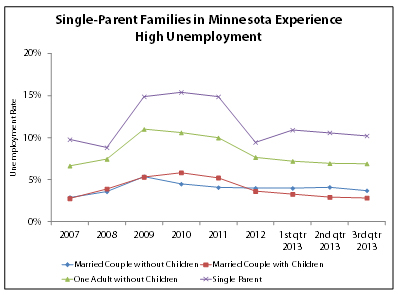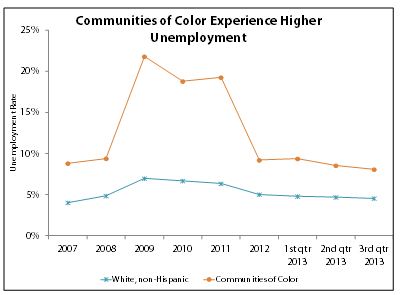The U.S. is still on the road to recovery from the Great Recession, an historical period of economic turmoil. In December 2007, the country entered a prolonged recession during which housing prices plummeted and unemployment skyrocketed. Although the recession officially ended in June 2009, the economic recovery has been slow and unsteady, leaving many families struggling to get back on their feet.
Minnesota weathered the Great Recession better than most states. By September 2013, the state’s unemployment rate was 5.0 percent, well below the national level. However, that figure translates into almost 148,000 Minnesotans still struggling to find jobs to support themselves and their families.[1] Extended periods of unemployment can force families to tap savings meant for education or retirement, and cut back on essentials like health care or food. As a result, unemployed Minnesotans find themselves falling further behind. That has consequences for the state as a whole since continued economic growth depends on opportunities for all.[2]
A closer look at of Minnesota’s unemployment figures highlights disturbing disparities. While overall unemployment is now close to what it was before the start of the recession, some Minnesotans were hit especially hard during the last few years and continue to have a difficult time finding work, including the less educated, the young, single-parent families and people of color.
Minnesotans with Less Education Struggle in the Job Market
Minnesotans with higher levels of education had more success staying employed through the recession than those with a high school diploma or less. Even during the economic recovery, Minnesotans with lower levels of education are finding it far more difficult to find employment.

- Minnesotans without a high school diploma experience much higher rates of unemployment than those with a high school diploma or more education. In the third quarter of 2013, 13.2 percent of Minnesotans without a high school education were unemployed. Although this is a significant improvement from the end of the recession in 2009, when almost one in five job-seeking Minnesotans without a high school diploma were unemployed, this level is still disturbingly high.
- For those with a high school diploma, unemployment dropped to 6.5 percent by late 2013. While still higher than the state average, this was a marked improvement from the recession high of 11.2 percent.
- Minnesotans with a college diploma weathered the recession far better than others, maintaining a relatively low unemployment rate. By September 2013, the unemployment rate for college graduates was just 3.2 percent.
Younger Minnesotans Experience High Unemployment
Young Minnesotans looking to enter the workforce during the recession got a late start in the job market, a significant setback at a critical time in their working careers that may harm their future earnings. Unemployment has declined substantially among young adults since the recession ended, but they are still struggling in the job market.

- Young Minnesotans experienced very high rates of unemployment during the recession: in 2009, unemployment for 16- to 24-year-olds reached 13.5 percent. This figure decreased considerably, falling to 8.4 percent in the first quarter of 2013, but climbed back to 9.1 percent in the third quarter. Young Minnesotans’ unemployment rate remains substantially higher than for other age groups.
- Other age groups saw a less dramatic change in employment patterns during the recession and recovery. For 25- to 44-year-olds, the unemployment rate fell to 4.2 percent in the third quarter of 2013; and for 45- to 64-year-olds, the rate was 4.6 percent. Both age groups saw an increase in unemployment during the recession, but have seen a steady decline since then.
Single-Parent Families Are Struggling Through Minnesota's Economic Recovery
Households headed by a single adult experienced much more difficulty in the job market during the economic downturn than married couples, with single-parent families facing the greatest challenges. The unemployment rate has improved for all households since the recession ended, but it still remains high for single-parent families and single adults without children.

Prolonged unemployment can be harmful to children, with the loss of wages making it difficult to provide nutritious meals and a safe environment, and parental stress causing greater tension in the home.[3]
A household headed by a single adult is particularly vulnerable during an economic downturn, since there isn’t a second income earner to help weather a stretch of unemployment.
- Single parents experienced very high unemployment rates during the recession, and by the third quarter of 2013, one out of 10 were still looking for work.
- Single adults without children are also living with high levels of unemployment. In the third quarter of 2013, 6.9 percent of single adults were seeking employment. While unemployment among this group has improved since the recession ended, the percentage seeking employment still exceeds the statewide average.
- Married couples – with and without children – have seen fairly low levels of unemployment for the past few years, never going above 6 percent since the recession began. For this analysis, a married couple is defined as experiencing unemployment if at least one of them is in the workforce and unemployed. In the third quarter of 2013, unemployment among married couples without children was 3.7 percent and among couples with children the rate was 2.8 percent.
Minnesota's Communities of Color Experience High Unemployment
Unemployment among people of color in Minnesota skyrocketed during the Great Recession, but as the economy has improved, these communities have once again found opportunities in the workforce. However, unemployment remains higher for people of color than white Minnesotans.[4] This likely reflects many of the other unemployment gaps discussed in this paper, including differences in educational attainment, age, family structures, as well as discrimination in the labor market.[5]

- While unemployment has consistently been higher among people of color compared to white Minnesotans, the rate for people of color jumped to more than three times the rate for white Minnesotans in 2009.
- Unemployment for both groups has fallen to pre-recession levels, but the unemployment rate for people of color is still 3.5 percentage points higher than for white Minnesotans.
- Many communities experience much higher unemployment than what is shown in the graph. The unemployment rate in 2012 was 19.2 percent for Native Americans in Minnesota and 17.7 percent for African Americans.[6]
Persistent Employment Disparities Should be Addressed
Many Minnesotans continue to struggle with a lack of economic opportunity four years after the recession officially ended. While many in the state have recovered, disparities persist. Those groups who were hit especially hard during the recession – the less educated, the young, single-parent families and people of color – are still living with high unemployment.
Although state policymakers have little influence over national economic trends, Minnesota can take steps to remove barriers to employment. For example, state policymakers can help low-income individuals in the Minnesota Family Investment Program (MFIP) be more successful in gaining jobs that lift their families out of poverty. These parents will have a better chance at employment if they can access Adult Basic Education so they can earn a GED, ESL classes so they can improve their English language skills, and post-secondary education so they can increase their earning potential.
The continuing disparities in unemployment are troubling, but by channeling resources to where they can do the most good, Minnesota can be a state where everyone has the opportunity to succeed.
By Caitlin Biegler